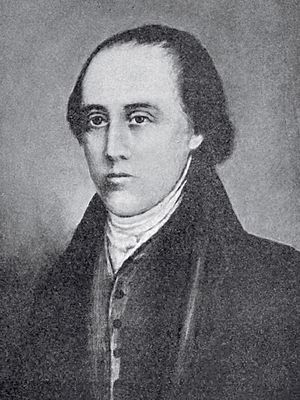John Filson facts for kids
John Filson (born around 1747 – died October 1788) was an important American writer, historian, and explorer. He helped found the city of Cincinnati, Ohio. Filson was also a pioneer and a surveyor, which means he measured land.
Contents
John Filson's Early Life and Work
John Filson was born in Chester County, Pennsylvania, around 1747. He went to West Nottingham Academy in Colora, Maryland. He also studied with Reverend Samuel Finley, who later became the president of Princeton University.
Before moving west, Filson worked as a schoolteacher. He was also a surveyor in Pennsylvania. In 1782 or 1783, he bought a lot of land in the western areas. This led him to move to Kentucky.
Exploring and Writing About Kentucky
When Filson moved to Kentucky, he settled in Lexington. He continued to teach school and survey land. He also traveled around the region. He talked to many settlers and important people there.
During this time, he wrote a famous book. It was called The Discovery, Settlement and Present State of Kentucke. He went to Wilmington, Delaware, to get it published in 1784.
Filson also had a "Map of Kentucke" made. It was printed in Philadelphia. The book and map together cost $1.50. This map was printed many times before 1793.
Why Filson's Book Was Important
Filson's book was very popular. It was quickly translated into French in Paris (1785). A German version also came out later (1790).
A special part of the book was about the adventures of Daniel Boone. This section was extremely popular. Even the famous writer Lord Byron mentioned it in his poem Don Juan.
Another writer, Gilbert Imlay, later reprinted Filson's work. He included it in his own book, A Topographical Description of the Western Territory of North America.
Founding the City of Cincinnati
After some years in Kentucky, Filson bought land near the Ohio River and Licking River. This land would become the city of Cincinnati. He bought a part of an 800-acre area from Mathias Denman.
Filson named this new settlement Losantiville. He created this name from different languages. "Los" came from Latin for "mouth." "Anti" came from Greek for "opposite." "Ville" came from French for "city." This name described its location opposite the mouth of the Licking River.
Filson's plan for the town is still seen in downtown Cincinnati today. In 1790, Governor Arthur St. Clair changed the name. He renamed Losantiville to Cincinnati. This was to honor the Society of the Cincinnati, a group of Revolutionary War officers.
Filson's Disappearance
In October 1788, John Filson was on a surveying trip. He was near the Great Miami River. During this trip, his group was attacked by Shawnee people. Filson disappeared and his body was never found.
After he disappeared, his business partners took over his share of the land. His family never benefited from the land's value. John Filson never married and had no children.
Legacy
Today, The Filson Historical Society in Louisville, Kentucky is named after him. It helps keep his memory and his work alive.



